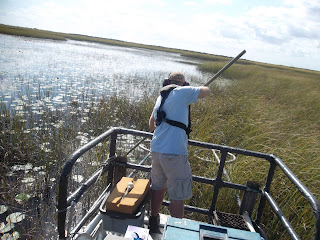Fish on the Move
Our full time bloggers are recovering from the FCE-LTER Beach BBQ this weekend so we've asked Mike Bush from the Department of Biology to talk about his research on fish movement in the Everglades.
---------------------------------------------------------------------------------------------------------------------------------------
Identifying patterns of animal movement is an important part of most conservation programs. As Everglades restoration continues, identifying how fishes respond to changes in water flow, removal of levees, etc. will provide us with important information about how restoration is changing the Everglades. I’m going to briefly discuss some of my work with large fish movement in the central Everglades.
Starting in May 2011 and continuing almost uninterrupted through today, I’ve been tracking two different fish species in an area known as the Gap (between Water Conservation Areas 3A and 3B). The fish are largemouth bass and bowfin, two big species that are common predators in the Everglades, gobbling up small fish and invertebrates as they patrol the marsh. I picked bass to study because they represent an important fishery in the Everglades, and few tracking days go by when I don’t have a discussion with bass fishermen about what I’m doing or Everglades restoration. Bowfin were chosen as the other species because they are a common predator, happily residing in both wide open canals and the thickest patch of sawgrass you can find.
This study is a small piece of a very large project known as the Water Conservation Area 3 Decompartmentalization and Sheet Flow Enhancement Project (DPM). DPM is a multi-agency and institution effort designed to look at the effects that restoring flow patterns have on animals, plants, water retention, sediment transport…just about anything you can think of. I catch my fish by electroshocking (see Ross' post to learn more about electroshocking) via airboat.
 |
| Netting an electroshocked fish out of the marsh. Surgery gear makes for a crowded boat! Photo by Justin Dummit |
Bass and bowfin get knocked out with an anesthetic, and then, as quickly and safely as we can, a technician holds down the fish upside down while I surgically implant a small radio transmitter near the fish’s gut. The fish is then allowed to recover and is released near where we caught it. The transmitter batteries last 4-6 months, and I try to find the fish on a weekly basis until the battery dies. To date, 81 fish, about 40 of each species, have been implanted with transmitters.
I’m still working on analyzing the data, but I can tell you that patterns are hard to identify! Some fishes only move a matter of meters from week to week. Other fish move kilometers every week! Many fish do something in-between, where they might move a few kilometers every week, and then they seem to find a spot they like, a home range, where they only move a few dozen meters a week, usually focused around one slough.
| Telling the airboat driver to turn around in the marsh, probably right on top of a fish. Photo by Hana Nardi |
These patterns will be important to identify to let us know how these top-level predators are moving around the Everglades, and how restoration projects are affecting the important fishery they represent. The culverts used to restore flow for DPM are set to open soon and I'll check back in with you then (with some cool construction photos) to give you updates on this project.
Mike Bush
Department of Biology
mbush002@fiu.edu


Comments
Post a Comment